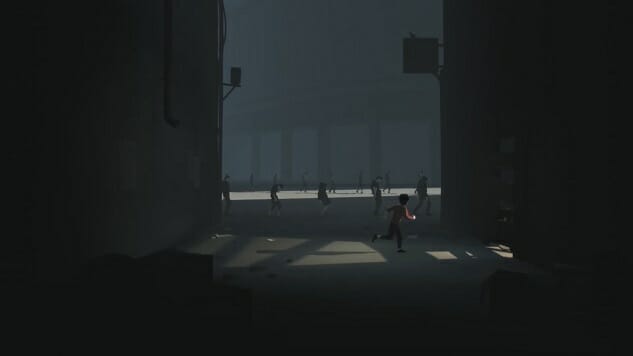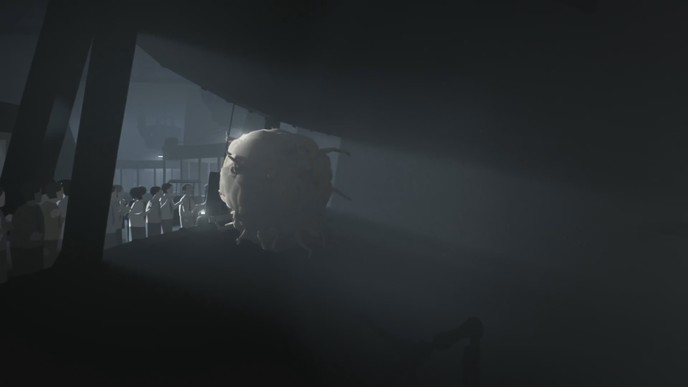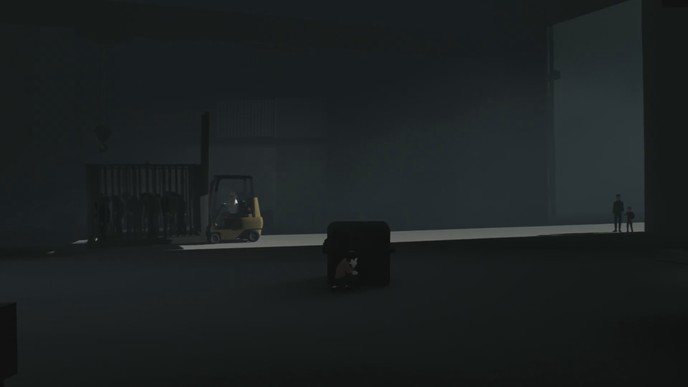
Inside, the sophomore release from Danish studio Playdead, presents a world of class division, capitalism and body horror. This abstract, wordless experience critiques the ways bodies are used and abused in societies today, particularly as a result of those same class divisions and capitalist structures. Inside’s society has not only stripped people of their identities, but of their very personhood. What is left are mere bodies, which are then further violated. The bodies of working class people are used as simple, mindless tools. The horrors of capitalism and class divisions are echoed throughout this bleak world.
Inside’s society shows no respect for the bodily sanctity of individuals and makes everyone, even the player, complicit. Inside’s society has eradicated the free will of the masses. The vast majority of the people you see in Inside are mindless husks, marching forward, under unseen control. These controlled bodies walk with an inhuman gait, marching as though they are about to fall over, their head down, barely even supported on their shoulders. The player is made to take direct control of these bodies if they want to progress. Many of Inside’s puzzles are solved through a device that allows the player to control the movement of nearby bodies. One puzzle in particular brings the inherent dehumanization to the forefront. It presents the player with a pressure plate and giant monitor nearby, displaying the number “40.” Every time a body is placed on this pressure plate, the number decreases. The player must then search every corner of the surrounding area for bodies. When the player approaches one, thanks to the control device, it will get up and begin to follow them. One of the last bodies the player happens upon is dead, so they must drag the body and throw it over a ledge to get it onto the pressure plate. It lands with a distant thud. What were once humans become mere resources for the player, a number. The structure and solution to this and other puzzles force the player to become complicit with the systemic dehumanization of people. The boy who serves as the main player character may be resisting the society, but merely interacting with it on any level necessitates violating and dehumanizing people, no matter one’s intentions. With every press of the button, the player chips away at the humanity of these people, turning them into a utility for progress.
The effects of constant abuse of bodies manifests itself visually through Inside’s body horror. The most apparent manifestation of a lack of personhood is the fact that there is not a single body with a face throughout Inside. Even the boy you play as is faceless. In its final act, Inside uses some of the most disturbing body horror I have seen to cement its critique of the systemic use and abuse of bodies in modern society. The boy comes upon a laboratory where all the scientists and workers are staring into a giant tank. Unable to see inside, the boy eventually makes his way into the tank and finds a giant mass of writhing, squirming body parts smushed together into a horrible blob. This blob of human bodies grabs the boy and pulls him in. It then escapes and begins to wreak havoc. It was deeply unsettling to watch this thing move about with a dozen or more arms and legs sticking out everywhere. The white collar office workers and the scientists observed the mutating mass of bodies with a perverse fixation, akin to a 19th century operating theater. In this abomination, the boy and everyone else who are a part of it weren’t just ripped of their personhood; all semblance of ever having been a person was completely obliterated into a squirming mass of limbs and flesh.
As the player continually witnesses the abuse of bodies and even participates in that abuse to move forward, Inside connects this dehumanization to the capitalist society the boy is enveloped in. All of the bodies are those of working class people, the masses. Occasionally, we gain glimpses of those who maintain an iota of freedom and identity, those who are not shambling husks. They are guards, office workers, scientists, business people. They work in offices that echo Western corporate culture, atriums that look like the lobbies of buildings, or modern scientific laboratories. From these places they use working class bodies as tools. One scene features a person showing their child the storage facility for the working class bodies. They watch as a worker then uses a forklift to pick up a cage full of these unaware bodies, and drives off. This imagery and setting explicitly places the dehumanizing actions in what is a recognizably modern society built on the separation of classes.
Inside ultimately encourages us to examine the way we treat and mistreat people and their bodies. These abuses are simply stylized versions of real world atrocities. The inherent dehumanizing nature of capitalism in pursuit of profits has led to the abuse of workers the world over. These horrors aren’t just occurring in far off countries; the systematic abuse of workers is being perpetrated by Americans and Europeans and companies they own. Walmart, a symbol of American consumer culture, sells shrimp that were processed by trafficked migrant laborers in Thailand. These workers were forced to work against their will by employers who had confiscated their work permits, health cards, ID’s and passports. They were then monitored by guards in case they tried to escape. These types of practices even occur within America’s borders. Global Horizons, a U.S. based worker recruitment program, brought hundreds of Thai farm workers to the U.S. and then confiscated their documents and threatened them with deportation if they did not keep working for them. The 2022 FIFA World Cup is being held in Qatar, where migrant slave laborers are building the infrastructure and stadiums. Estimates report that one person working on World Cup infrastructure in Qatar dies every day due to working conditions and the inability to quit or leave. More than 4,000 slave laborers will ultimately die by the time the 2022 FIFA World Cup begins. These are just a fraction of modern horrors caused by global capitalism. And yet, people will still shop at Walmart. People will still watch the World Cup.
“We are all implicated in this problem,” journalist Noy Thrupkaew said in her talk on human trafficking. By forcing the player to abuse working class bodies in order to progress, Inside sends a similar message. In puzzle after puzzle, body after body, Inside says that class divisions and capitalism pervert and disturb and we are all complicit, no matter our intentions. Inside culminates with an abomination that was created due to the total lack of respect for workers and their bodies as anything more than tools. The game argues that we must acknowledge the abominations we have allowed to be made for our convenience at the expense of people and their bodies.
Kyle McKenney writes for Swarthmore College’s student newspaper the Daily Gazette and is an intern at Paste. You can follow him on Twitter @TotallyKyle95.


